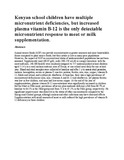Kenyan school children have multiple micronutrient deficiencies, but increased plasma vitamin B-12 is the only detectable micronutrient response to meat or milk supplementation.

View/
Date
2003Author
Siekmann, JH
Allen, LH
Bwibo, NO
Demment, MW
Murphy, SP
Neumann, CG
Type
ArticleLanguage
enMetadata
Show full item recordAbstract
Animal source foods (ASF) can provide micronutrients in greater amounts and more bioavailable forms compared to plant source foods, but their intake is low in many poor populations. However, the impact of ASF on micronutrient status of undernourished populations has not been assessed. Supplemental meat (60-85 g/d), milk (200-250 mL/d) or energy (isocaloric with the meat and milk, 240-300 kcal/d) were randomly assigned to 555 undernourished school children aged 5-14 y in a rural malaria-endemic area of Kenya, at one school meal daily for one school year. Blood and stool samples were collected at baseline and after 1 y to assess stool parasites, malaria, hemoglobin, serum or plasma C-reactive protein, ferritin, iron, zinc, copper, vitamin B-12, folate and retinol, and erythrocyte riboflavin. At baseline, there was a high prevalence of micronutrient deficiencies (iron, zinc, vitamins A and B-12 and riboflavin), yet plasma ferritin was low in few children, and none had low serum copper. At the end of the year of supplementation, plasma vitamin B-12 concentrations were significantly increased in children fed the Meat or Milk meal; prevalence of severe plus moderate deficiency fell from 80.7% at baseline to 64.1% in the Meat group and from 71.6 to 45.1% in the Milk group, respectively. No significant improvement was observed in the status of other micronutrients compared to the Energy and Control groups, although malaria and other infections may have obscured effects. Supplementation with small amounts of meat or milk reduced the high prevalence of vitamin B-12 deficiency in these children
URI
http://www.ncbi.nlm.nih.gov/pubmed/14672298http://erepository.uonbi.ac.ke:8080/xmlui/handle/123456789/15985
Citation
J Nutr. 2003 Nov;133(11 Suppl 2)Publisher
Program in International Nutrition, University of California, Davis, CA 95616, USA
Collections
- Faculty of Health Sciences (FHS) [10378]
